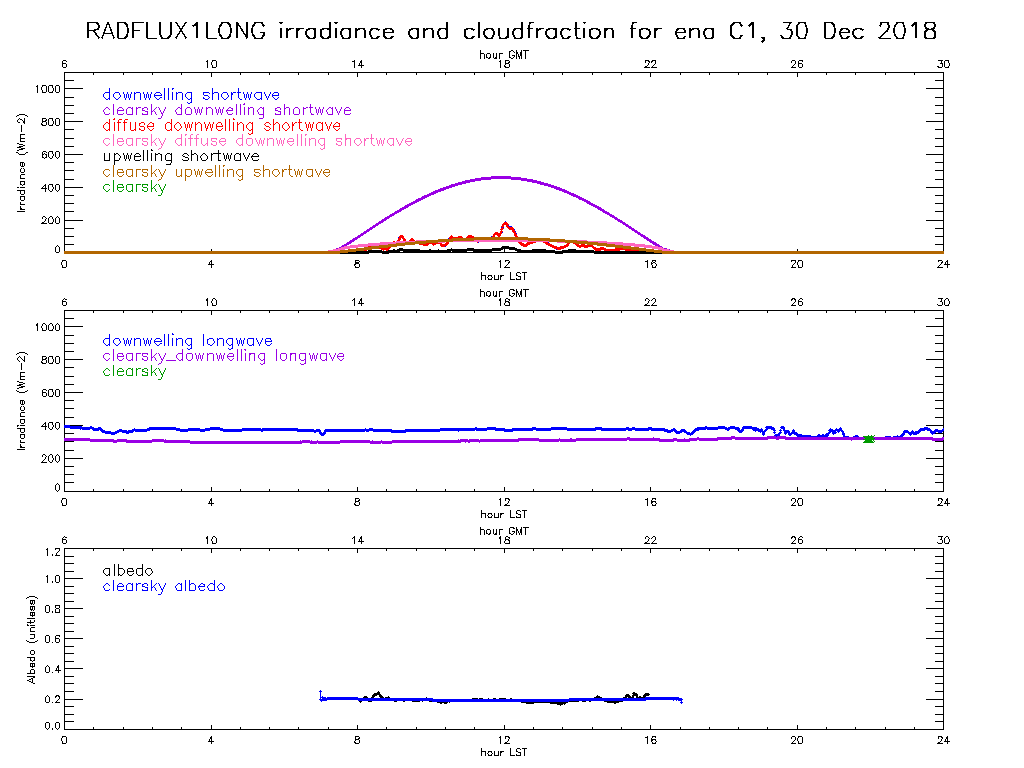New Radiative Flux Analysis VAP Data Released
Published: 22 September 2020

An assortment of new data is now available from the Radiative Flux Analysis (RADFLUXANAL) value-added product (VAP).
RADFLUXANAL calculates clear-sky irradiance in the shortwave and longwave surface fluxes from broadband irradiance measured at Atmospheric Radiation Measurement (ARM) user facility sites. This VAP also calculates fractional sky cover and cloud parameters, including effective visible cloud optical depth, cloud radiating temperature, and shortwave cloud transmissivity, from the measurements.
New RADFLUXANAL c2-level data are available for the following ARM mobile field campaigns:
- ARM West Antarctic Radiation Experiment (AWARE) at McMurdo Station, Antarctica: November 24, 2015, through December 19, 2016
- Layered Atlantic Smoke Interactions with Clouds (LASIC) on Ascension Island: May 12, 2016, through November 1, 2017
- Cloud, Aerosol, and Complex Terrain Interactions (CACTI) at Córdoba, Argentina: September 23, 2018, through April 27, 2019.
New RADFLUXANAL c2-level data are also available for the following long-term ARM sites:
- Eastern North Atlantic atmospheric observatory on Graciosa Island, Azores: September 22, 2017, through October 17, 2019
- North Slope of Alaska atmospheric observatory at Utqiaġvik (formerly Barrow), Alaska: September 17, 2017, through July 11, 2019
- Oliktok Point, Alaska: October 3, 2017, through July 11, 2019
- Southern Great Plains (SGP) Central Facility near Lamont, Oklahoma: June 6, 2016, through August 27, 2019
- SGP extended facility E9 (Ashton, Kansas): May 30, 2016, through August 19, 2019
- SGP extended facility E11 (Byron, Oklahoma): May 30, 2016, through July 30, 2019
- SGP extended facility E12 (Pawhuska, Oklahoma): May 28, 2016, through August 19, 2019
- SGP extended facility E13 (Lamont, Oklahoma): June 16, 2017, through August 19, 2019
- SGP extended facility E15 (Ringwood, Oklahoma): June 6, 2016, through August 18, 2019
- SGP extended facility E21 (Okmulgee, Oklahoma): June 8, 2016, through April 26, 2019
- SGP extended facility E31 (Anthony, Kansas): May 30, 2016, through July 24, 2019
- SGP extended facility E32 (Medford, Oklahoma): July 10, 2016, through June 9, 2019
- SGP extended facility E33 (Newkirk, Oklahoma): July 23, 2016, through June 9, 2019
- SGP extended facility E34 (Maple City, Kansas): July 23, 2016, through July 19, 2019
- SGP extended facility E35 (Tryon, Oklahoma): July 20, 2016, through June 23, 2019
- SGP extended facility E36 (Marshall, Oklahoma): July 20, 2016, through June 23, 2019
- SGP extended facility E37 (Waukomis, Oklahoma): July 18, 2016, through June 19, 2019
- SGP extended facility E38 (Omega, Oklahoma): July 18, 2016, through July 23, 2019
- SGP extended facility E39 (Morrison, Oklahoma): July 22, 2016, through September 3, 2019
- SGP extended facility E40 (Pawnee, Oklahoma): June 20, 2017, through July 22, 2019
- SGP extended facility E41 (Peckham, Oklahoma): June 24, 2017, through May 30, 2019.
In addition, reprocessed RADFLUXANAL c2-level data from the long-term sites listed above are newly available. Read about the reprocessing in this data announcement.
(Note: The SGP sites have different start/end dates because they have different instrument swap dates.)
Scientists can use the RADFLUXANAL data now. To access these data, please log in to the ARM Data Center. (Go here to create an account to download the data.)
More information about RADFLUXANAL can be found on the VAP web page. To share your experience with RADFLUXANAL—such as how you use the data and how well they work for you—or to ask a question, contact ARM translator Damao Zhang.
To cite the RADFLUXANAL data, please use doi:10.5439/1395157.
Keep up with the Atmospheric Observer
Updates on ARM news, events, and opportunities delivered to your inbox
ARM User Profile
ARM welcomes users from all institutions and nations. A free ARM user account is needed to access ARM data.


















